In this article
Getting the right climbing shoe fit isn’t just about comfort; it’s a fundamental step on the path to better climbing. This guide explores why fit is so critical, helps define the line between a performance-enhancing snugness and damaging pain, examines factors influencing your ideal fit, and looks at how shoe features play a role. We’ll also navigate the tricky world of sizing and offer some top climbing shoes recommendations. Let’s map out how to find that perfect balance for your feet.
Why Fit Matters Critically
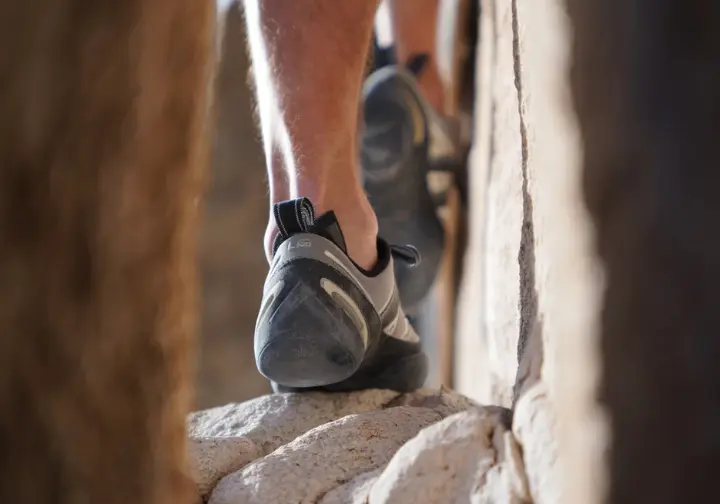
Achieving the correct climbing shoe fit is foundational for performance, safety, and long-term foot health. It goes far beyond simply feeling okay; the right fit transforms the shoe into an extension of your foot, unlocking potential and preventing problems down the road. Let’s explore why dialing in this connection is so important for every climber.
The Performance Edge
Think of a precisely fitted climbing shoe as a crucial piece of equipment, not just footwear. This snug connection ensures the shoe mirrors every subtle movement of your foot, maximizing power transfer. This is especially vital when pushing off tiny edges or trusting your feet on smooth smears where accuracy is everything. Without that direct link, your technique can falter on the rock.
Enhanced sensitivity is another significant advantage. A snug fit allows you to feel the texture and shape of the rock or indoor holds beneath your feet. This tactile feedback is invaluable, informing your foot placements and leading to more secure, efficient movement. Feeling the hold builds essential trust in your footwork, making you a more confident climber.
Conversely, a shoe that’s too loose permits your foot to shift internally. This movement wastes energy, reduces the power directed to your toes, and seriously compromises your ability to edge effectively. Such instability can lead to unexpected slips, particularly on small or insecure footholds, undermining both performance and confidence during a climb. Have you ever felt your foot swim inside a shoe on a critical move?
A secure heel cup is also non-negotiable for techniques like heel hooking. A snug fit locks your heel in place, preventing it from lifting out during powerful pulling moves. A loose heel renders heel hooks ineffective and insecure. Getting this right provides stability when you need it most for vertical moves.
Ultimately, a well-fitted shoe lets you trust your feet completely. This frees up mental energy, allowing you to focus on the climb—the sequence, the movement, the problem-solving—rather than worrying about potential slips or distracting discomfort. This mental clarity is a powerful, often underestimated, component of pushing your limits in climbing.
Foot Health Hazards
While performance is key, protecting your feet is paramount. Excessively tight climbing shoes are a direct route to immediate problems like painful blisters, pressure sores (often called “hotspots”), and general discomfort that can abruptly end a climbing session. These issues arise quickly when intense pressure is focused on small areas of the foot.
Ignoring that initial pain can lead to more severe, long-term consequences. Consistently wearing overly tight climbing shoes risks structural foot changes like bunions (hallux valgus). Nerve compression or damage is another serious concern, potentially causing numbness or chronic pain. Sacrificing foot health for a perceived edge is never a worthwhile trade-off when selecting footwear.
Other chronic issues stemming from poor fit include the formation of painful calluses, Achilles tendon problems due to excessive pressure or rubbing, and potential damage to toe joints and ligaments. These conditions often require significant time away from climbing to heal properly. Prevention through proper fit is the best approach for all climbers.
Pain is your body’s natural warning system; it signals potential harm. While high-performance fits might involve some discomfort, they should never cause debilitating pain that risks injury. Learning to distinguish productive tightness from harmful pain is a skill. Listen carefully to what your feet are telling you about the shoes.
Choosing a shoe that fits correctly not only prevents injury but also enables better performance and longer climbing sessions without foot agony forcing you to stop. The objective should always be sustainable performance and enjoyment, not pain endurance. Finding the right climbing shoe fit truly makes a difference for your climbing journey.
Decoding Snug vs Painful
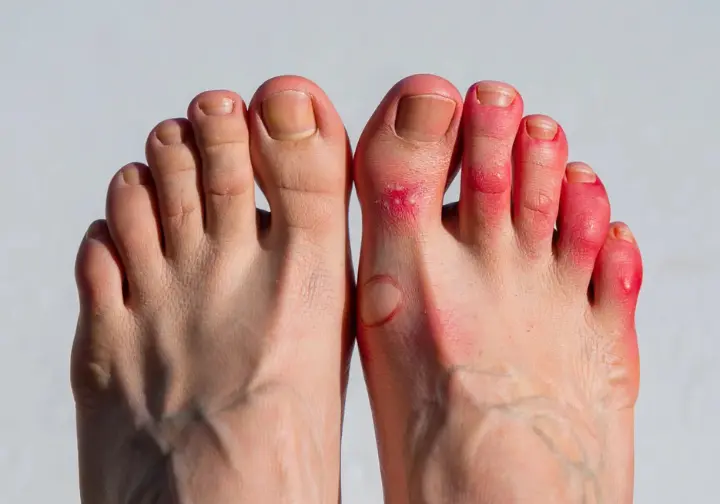
Understanding the difference between a beneficial “snug” fit and a harmful “painful” fit is perhaps the most critical part of the climbing shoe selection journey. One enhances your climbing, the other detracts from it and risks injury. Let’s pinpoint the characteristics of each to help you find that ideal sweet spot in your shoes.
Defining Performance Snug
A genuinely snug fit means zero “dead space” inside the shoe. The material should sit flush against your foot everywhere, with no gaps or air pockets, especially around the heel and arch. This creates a precise, second-skin feel, allowing the shoe to respond instantly to your foot‘s commands. No internal movement equals maximum control and better traction.
Your toes should reach the very end of the toe box, making contact with the front. Depending on the shoe‘s design (neutral, moderate, or aggressive), your toes might lie flat, be slightly bent, or adopt a more actively curled position. The key is contact without painful jamming or crushing pressure on the knuckles; the foot position is crucial.
The heel cup must feel secure, almost suctioned onto your foot. Test this by weighting your toes or mimicking heel hook movements; there should be absolutely no lifting or shifting. Press around the heel area to check for hidden air pockets. A locked-in heel provides crucial stability and power for bouldering and route climbing.
The overall sensation should be one of uniform compression, like a firm handshake enveloping your entire foot, not isolated points of intense pressure. It should feel contained and supported. Uneven pressure often indicates a shape mismatch, even if the size seems right. How does the pressure feel distributed in your current climbing shoes?
While not designed for walking around comfortably, a performance-snug fit should be tolerable for the duration of a climb or bouldering attempt. It’s perfectly normal to want to remove them between climbs. A bad sign is actively dreading putting them on due to anticipated pain. Manageable discomfort is distinct from agony when you wear these specialized shoes.
Recognizing Problem Pain
Sharp, localized pain is the clearest indicator that a shoe fit is wrong and potentially damaging. Pay attention to intense pain over knuckles, specific joints, or the Achilles tendon – these are classic “hotspots.” This type of pain is fundamentally different from the feeling of general tightness or compression associated with a performance fit in climbing footwear.
Pain is inherently distracting. It pulls your mental focus away from technique, movement strategy, and safety awareness during a climb. It can also cause you to alter your footwork unnaturally to avoid pressure points, leading to inefficient climbing and potentially straining other parts of your body. Compensating for foot pain often results in developing poor movement habits.
The myth that climbing shoes must hurt to perform well is persistent, inaccurate, and harmful. It often leads climbers, especially beginners, to endure unnecessary pain and increase their risk of injury. Expert advice consistently refutes this notion, emphasizing that while some discomfort might accompany high-performance fits, actual pain should always be avoided. Finding the right climbing shoes doesn’t mean finding painful ones.
Numbness or tingling sensations in your toes or parts of your foot are serious red flags. These symptoms indicate restricted blood flow or nerve compression due to excessive tightness. This is not something to ignore or push through; it signals a dangerously tight fit that requires immediate correction by choosing a larger size or different model shoe.
If getting the shoes on requires extreme effort – like needing plastic bags for assistance or enduring significant pain just during the process – they are almost certainly too small or the wrong shape for your foot. The fitting process shouldn’t feel like an ordeal. Excessive struggle points to a poor match between shoe and foot.
Factors Influencing Your Fit
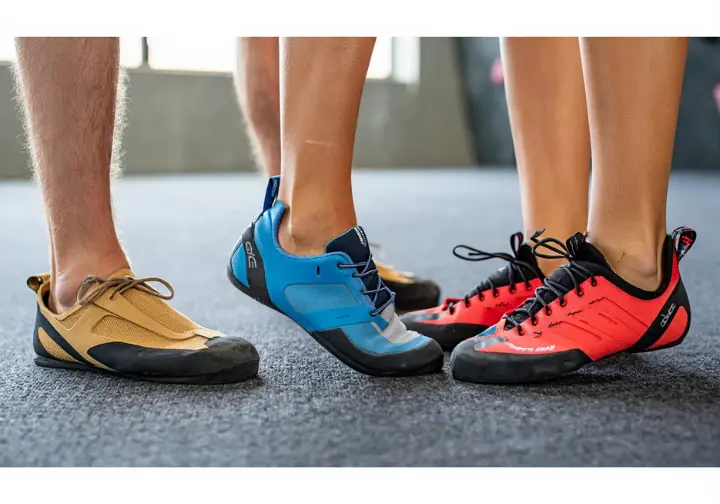
Finding the right climbing shoe fit isn’t a one-size-fits-all equation. Several personal and contextual factors significantly influence the type of shoe and the level of snugness that will work best for you. Considering these elements helps narrow down the vast shoe options and guides you toward a more personalized fit.
Experience Level Matters
For those just starting their climbing journey, comfort should be the top priority. Focus on learning fundamental footwork techniques without the distraction of painful shoes. An overly tight, aggressive fit can discourage new climbers and hinder skill development by making them hesitant to fully weight their feet. Enjoyment and learning are paramount initially.
A neutral shoe, characterized by a relatively flat profile, fitted snugly but comfortably (often allowing toes to lie mostly flat), is generally the best starting point for novices. At the beginner stage, the climbing shoe itself is rarely the limiting factor; mastering technique is far more important. Comfortable shoes facilitate this learning process.
As you gain experience and start tackling more challenging routes or boulder problems, you might find benefit in moderately or aggressively downturned shoes. These designs often require a tighter fit to maximize power on small holds. This progression typically aligns with developing a better understanding of the trade-offs between performance and comfort in climbing footwear.
Intermediate and advanced climbers often develop a higher tolerance for the discomfort associated with snug performance fits. They understand it can be a necessary element for executing specific climbing moves. Crucially, experienced climbers learn to differentiate between productive tightness that aids performance and damaging pain that risks injury. This wisdom comes with time on the rock or at the gym.
Many seasoned climbers, including the veteran climber, eventually build a “quiver” of shoes. They might have comfortable neutral shoes for long days, moderate shoes for versatile performance, and aggressive shoes for steep projects. This allows them to select the optimal tool—balancing performance and comfort—for the specific climbing demand of the climb or bouldering session ahead.
Climbing Discipline Dictates
The type of climbing you primarily engage in heavily influences shoe choice and fit. Bouldering and sport climbing frequently involve steep angles and precise footwork on small, challenging holds. This makes aggressive, downturned shoes with a very snug fit a popular choice, concentrating power onto the big toe.
Since bouldering and single-pitch sport climbing routes involve shorter bursts of effort followed by rest periods, climbers can often tolerate tighter, more performance-focused fits. It’s common to remove shoes between attempts or climbs. This on-and-off wear pattern makes aggressive designs more practical than they would be for continuous, all-day use on long outdoor climbing routes.
Traditional (trad) and multi-pitch climbing usually demand comfort over extended periods, often hours at a time. This makes neutral or moderate shoes the preferred option. Flatter shoes allow the foot to remain in a more natural, less strained position, significantly reducing fatigue and the likelihood of debilitating pain high off the ground. Alpine climbing shares similar comfort needs.
While some climbers tackling very difficult trad routes might still opt for a snug performance fit, the general approach leans towards prioritizing comfort. Sacrificing a small amount of edging power for the ability to climb comfortably all day is often a necessary compromise. Foot pain deep into a long multi-pitch route can be more than just uncomfortable; it can become a safety concern, increasing the risk of a fall.
Crack climbing presents unique demands. This style requires shoes that allow the foot to lie relatively flat for comfortable jamming inside cracks. Aggressively downturned shoes are generally unsuitable and painful for this technique. Climbers typically select neutral, often stiffer shoes, sometimes sizing them slightly larger than their sport climbing shoes for better jamming comfort.
Your Unique Foot Shape
Every individual’s foot is different in shape and volume. Finding a shoe built on a “last” (the foot-shaped mold the shoe is constructed around) that closely matches your foot‘s characteristics is absolutely essential for avoiding painful hotspots and achieving a truly good fit. Key anatomical factors influencing foot shape include overall width, toe configuration, arch height, and heel volume. Consider gender specific shoes if standard fits don’t work.
Foot width varies considerably. Some brands and specific models are known for catering to wider feet, while others offer Low Volume (LV) versions designed for narrower feet. Trying on shoes from different manufacturers is vital. For example, some Butora models are noted for a wider fit, whereas certain La Sportiva italian climbing shoes often run narrower.
The relative lengths of your toes also play a role. Whether you have an “Egyptian” foot (big toe longest), “Greek” foot (second toe longest), or “Roman” foot (first few toes similar length) influences how well your foot fits into different toe box shapes (e.g., pointed vs. rounded vs. asymmetric). An incompatible toe box shape is a frequent source of fit problems and pain.
Heel shape and volume are equally important. A shoe might feel perfect in the forefoot but be baggy and insecure in the heel, allowing it to lift during heel hooks. Conversely, a heel cup might be too tight or poorly shaped, causing pressure on the Achilles tendon. Always check for a snug, secure heel fit without dead space or painful pressure points.
If a specific shoe model consistently causes pain in the same spot, even when trying different sizes, it’s highly probable that the shoe‘s last shape is fundamentally incompatible with your foot anatomy. Don’t try to force a fit that clearly isn’t working. It’s time to move on and try different models or brands known for distinct fit profiles. Even adaptive climbers need the right footwear match.
Shoe Features Impacting Fit

Beyond personal factors, the specific design and construction elements of a climbing shoe significantly influence how it fits and feels on your foot. Understanding these features—like the overall shoe type, the materials used, and the shoe closure system—provides further insight into finding the right shoe match and anticipating how the fit might evolve.
Shoe Type and Aggressiveness
Neutral shoes are built on a flat, symmetrical last. Their primary design goal is comfort, making them ideal for beginners, all-day wear, and crack climbing. The fit should be snug enough to prevent foot movement inside, but generally allows toes to lie flat or only slightly bent. These are often good all-around shoes.
Moderate shoes introduce a slight downturn (camber) and increased asymmetry. They strike a balance between comfort and performance, suitable for intermediate climbers or those tackling varied terrain requiring both edging and smearing. The fit needs to be snug enough to maintain the shoe‘s shape and allow the climber to effectively utilize the moderate downturn for power.
Aggressive shoes feature a significant downturn and high asymmetry. This design focuses power onto the big toe, making them specialized tools for steep rock, overhanging routes, and grabbing small holds. They demand a very snug fit, often requiring curled toes, to maintain the tensioned shape and deliver maximum performance on demanding terrain. Comfort is secondary here; these are often ultra-performance climbing shoes.
The need for a tight fit is directly related to the shoe‘s intended function. Aggressive shoes, in particular, rely on the tension created by a tightly held foot to maintain their downturned shape and performance characteristics. If worn too loosely, their specialized design advantage is largely negated. The fit essentially activates the shoe‘s potential on vertical walls.
Understanding the purpose behind each shoe type—neutral, moderate, or aggressive—helps you select an appropriate model and grasp the corresponding fit requirements. A neutral shoe generally offers more forgiveness in fit compared to a highly specialized, aggressive model designed for elite performance. Match the fit tightness to the shoe type and your shoe needs.
Materials and Stretch
The material used for the shoe‘s upper significantly impacts how it fits initially and how much it might stretch over time. Unlined leather offers the greatest potential for stretch, sometimes expanding up to a full size as it molds to the unique contours of your foot. Shoes made from unlined leather need to be sized very snugly at first to account for this eventual stretch.
Lined leather incorporates a fabric lining that drastically reduces the amount of stretch, typically limiting it to half a size or even less. This results in a more consistent fit throughout the shoe‘s lifespan compared to unlined options. The initial fit for lined leather should be snug, but perhaps less aggressively tight than for unlined leather.
Synthetic upper materials, such as Lorica or various microfibers, exhibit minimal to negligible stretch. This means the fit you feel when you first try them on in the shoes shop is essentially the fit you will have long-term. Precise initial sizing is absolutely critical with synthetic shoes, especially performance models where a perfect fit is paramount. The shoe material dictates this.
Some modern shoes utilize engineered knit uppers. These offer a comfortable, sock-like fit with excellent breathability while still providing structure and minimal stretch. They often prioritize comfort right out of the box but still demand accurate sizing for optimal performance. Knit uppers represent a blend of comfort and low-stretch predictability.
When trying on shoes, always factor in the upper material and its expected behavior. Size unlined leather very tightly, anticipating significant stretch. Size lined leather snugly, expecting less change. Size synthetics and knits precisely based on how they feel initially, as they won’t stretch much, if at all. This material awareness is key to long-term fit success.
Closure System Impact
The shoe closure system—laces, straps (Velcro), or elastic slippers—also affects the fit and feel. Lace-up closures offer the most customizable and precise fit adjustment. You can fine-tune tension along the entire length of the foot, accommodating variations in foot shape, managing swelling on long climbs, or dialing in performance for specific moves.
Strap closures provide significant convenience, allowing for quick on-and-off transitions. This makes them highly popular for bouldering and gym climbing, where shoes are frequently removed between attempts. They offer less granular adjustment compared to laces, often concentrating pressure where the straps cross the foot. Speed and ease are the main advantages.
Slipper designs rely primarily on elastic panels to achieve a snug, low-profile fit, often resulting in very sensitive shoes favored for specific climbing styles or intensive training sessions. Because there’s virtually no adjustability, the initial fit of a slipper must be spot-on. There’s no way to tighten or loosen them once they’re on your foot. Consider slip-lasted designs for sensitivity.
The interaction between the shoe closure and the upper material is also relevant. Lace-ups on leather shoes offer the most adaptability over time as the leather stretches and molds. Synthetic slippers, conversely, offer the least adaptability. Consider this interplay when choosing a shoe and deciding on the initial fit tightness.
Ultimately, choose a shoe closure system based on your primary climbing discipline and personal preference for adjustability versus convenience. Trad and multi-pitch climbers often prefer the fine-tuning ability of laces, while boulderers and gym climbers frequently opt for the speed of straps or the sensitivity of slippers.
Navigating Sizes and Brands
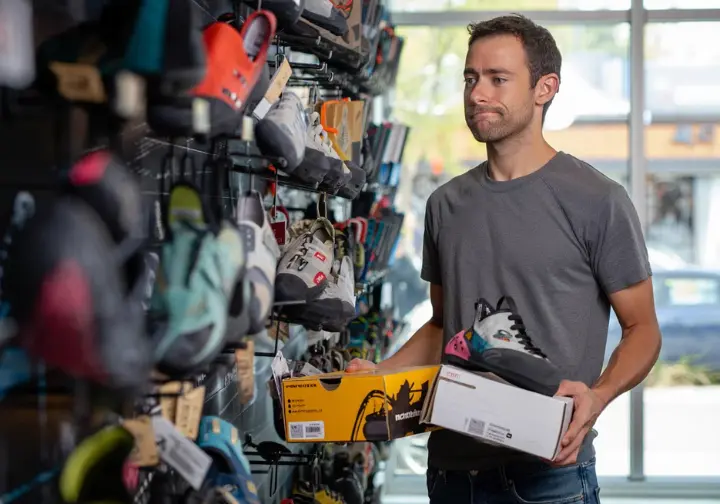
Entering the world of climbing shoe sizing can feel like navigating a maze. Sizes vary wildly, standard street shoes measurements are often irrelevant, and brand inconsistencies abound. Understanding these quirks and adopting best practices for trying shoes on is essential to finding your way to the right fit.
Beyond Street Shoe Size
The first rule of climbing shoe sizing: forget your street shoe size. It’s almost never a reliable indicator for climbing shoes. Climbers typically wear their climbing shoes significantly smaller than their everyday footwear to achieve the necessary snug, performance-oriented fit. Relying on your sneaker size is a common beginner mistake leading to poorly fitting shoes.
Many climbing shoe brands use European (EU) sizing. This system features smaller increments between half sizes compared to US or UK sizing. While this theoretically allows for more precise fit adjustments, it adds another layer of conversion complexity and potential confusion when comparing sizes across different systems or brands. Always check which system a brand uses for their shoes.
The purpose of sizing down isn’t to inflict pain, but to eliminate all dead space within the shoe. This maximizes sensitivity, allowing you to feel the holds better, and optimizes power transfer through the shoe‘s structure to your toes. The amount of downsizing required varies enormously based on the shoe, the brand, and the climber.
Downsizing too aggressively, however, is counterproductive. It leads to excessive pain, increases the risk of foot injury, can negatively impact technique, and ultimately hinders performance. Finding the delicate balance between snug enough for performance and too tight causing pain is the objective when seeking the perfect climbing shoes. More downsizing isn’t always better.
Several factors influence how much downsizing is appropriate. Shoe stiffness plays a role; soft climbing shoes might need a tighter fit than stiff ones for edging support, impacting the sole needs. The intended use (e.g., comfort for trad vs. precision for bouldering), material stretch, and your personal pain tolerance all contribute to determining the right downsize for a specific shoe and climber.
The Brand Sizing Maze
Prepare for inconsistency. There is a notorious lack of sizing standardization between different climbing shoe manufacturers. Worse yet, sizing can sometimes vary even between different models within the same brand. A size 42 in one brand can feel drastically different—larger or smaller—than a size 42 in another brand. Finding the right size takes effort.
While some general tendencies are often cited (e.g., one brand typically runs smaller than another, or one is closer to street shoe size), treat these as rough guidelines at best. They are subject to numerous exceptions based on the specific shoe model, the last it’s built on, and how its shape interacts with your foot. Online size comparison charts offer estimates only.
Real-world experience and online forums are filled with reports highlighting this variability. Climbers often find their shoe sizes span several numbers across their collection of different brands to achieve a comparable level of snugness. This underscores the unreliability of depending solely on size numbers when choosing shoes, especially when switching brands. Many climbers experience this.
Even manufacturer-provided sizing guides or recommendations can sometimes be misleading. They might suggest downsizing levels that result in excessive pain or an unworkable fit for many users. Always prioritize how the shoe actually feels on your foot over any chart recommendation or generalized advice. Your foot‘s feedback is the most reliable guide.
Given this landscape of inconsistency, trying shoes on in person remains, by far, the most reliable method for finding the correct size and model. Visiting a shoes shop or gym with a good selection and knowledgeable staff allows you to compare different brands and sizes directly. Relying solely on online purchases without trying shoes first is inherently risky.
Try-On Best Practices
Timing matters when trying on shoes. Aim to shop later in the day, typically afternoon or evening. Feet naturally swell slightly throughout the day, and fitting shoes when they are at their largest helps simulate how they’ll feel during a climbing session, preventing you from buying shoes that become painfully tight after warming up.
Try shoes on barefoot, as this is how most climbers wear them for maximum sensitivity and precision. If you specifically plan to wear socks (common for cold weather or alpine climbing), then try the shoes on with the exact type of socks you intend to use. Socks significantly alter the fit and usually require sizing up.
Don’t just try one size. Always try the size you think might fit, plus at least a half-size smaller and potentially a half-size larger. Comparing these subtle differences helps you pinpoint the best balance of snugness and comfort. Don’t get fixated on achieving a specific number; focus on the feel of the climbing shoe.
If a particular shoe model causes sharp, localized pain (hotspots) regardless of the size you try, it’s a strong indicator that the shoe‘s shape (last) is simply not compatible with your foot anatomy. Don’t persist. Switch to trying different models known for different fit characteristics (e.g., wider toe box, narrower heel) or explore other brands entirely.
Don’t just slip the shoes on and off quickly. Keep potential candidates on your feet for several minutes in the shop. Walk around carefully (though they won’t feel like street shoes), stand on your tiptoes, and utilize any available demo edges or small climbing walls. Assess how the shoe feels under pressure and during simulated climbing movements on slab or vertical terrain.
Pay meticulous attention to the key fit zones. Ensure your toes reach the end of the toe box without being painfully crushed or curled unnaturally (unless it’s an aggressive shoe designed for that position). Check that the heel is secure with no lift or dead space. Scan your entire foot for any specific points of intense pressure. Aim for uniform snugness.
If buying online is your only option, do thorough research on the specific model’s sizing reputation. Read numerous reviews, paying close attention to comments comparing its fit to other known models or street shoe sizes. Crucially, choose a retailer with a clear, flexible, and easy return policy, as you may need to order multiple sizes and return those that don’t fit.
Top Climbing Shoe Picks
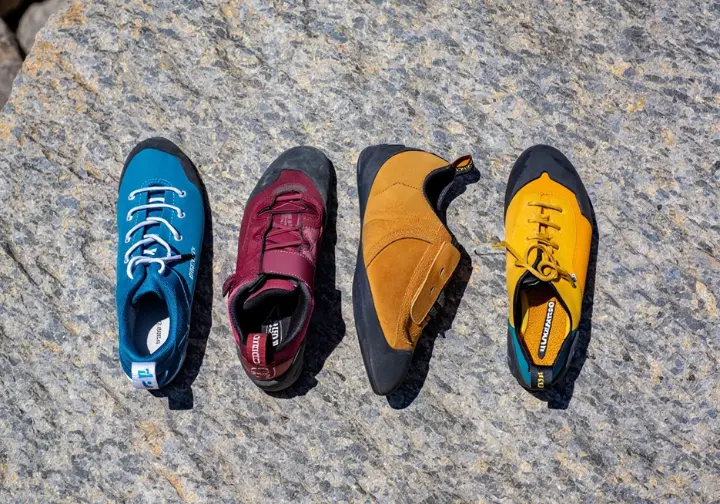
Based on the research and common recommendations, here are some popular climbing shoe models often cited for different needs and climbing styles. Remember, personal fit is paramount, so these serve as starting points for your exploration to find the right climbing shoes for you.
Best for Beginners
La Sportiva Tarantulace | Great all-around comfort and adjustability for learning
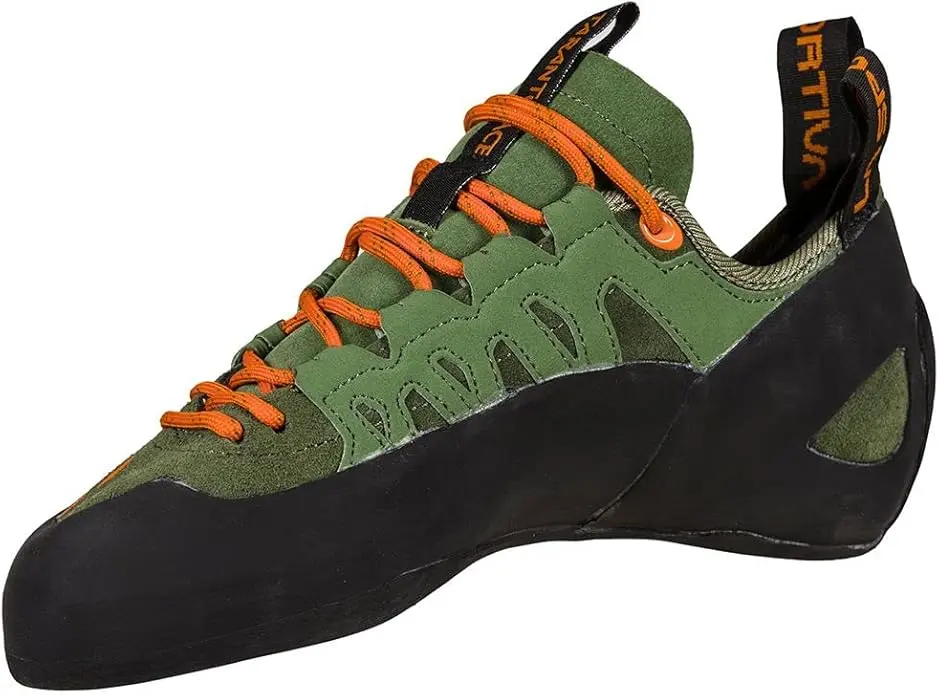
This shoe is frequently recommended for those starting out. Its unlined suede leather upper offers comfort and molds slightly over time, while the lace-up closure allows for precise adjustments across the foot – helpful as beginners learn what feels right. The neutral, slightly asymmetrical shape suits a wide range of feet and prioritizes comfort for longer gym sessions or initial outdoor ventures. The durable FriXion RS rubber provides reliable grip and traction for learning basic techniques on varied terrain.
The Tarantulace strikes a good balance between comfort, durability, and affordability, making it a solid choice for developing fundamental skills without the distraction of painful feet. Its supportive midsole aids edging, crucial for building confidence on smaller holds. While it stretches a bit, requiring a snug initial fit, its overall design focuses on making the entry into climbing enjoyable and accessible. It’s a versatile workhorse shoe for learning the ropes.
Many find this shoe comfortable for extended periods, reducing a common barrier for new climbers. The adjustability helps accommodate different foot volumes and allows for fine-tuning as the leather breaks in. It’s a well-regarded option among italian climbing shoes for those prioritizing comfort and a forgiving fit while navigating the initial stages of their climbing path.
PROS
- Unlined suede upper ensures all-day comfort
- Lace-up closure allows precise fit
- FriXion RS rubber provides reliable grip
- Durable for beginners (~6-12 months)
- Affordable (~$80-$100) for quality
- Suits wide and narrow feet with stretch
- Stylish colors (Olive/Tiger, Flame)
CONS
- Sizing runs small; 1/2-1 size down from street recommended
- Sole peeling reported after ~1 month by some users
- Leather stretches ~1/2 size, potentially loosening fit over time
- Laces may fray over time
- Limited precision for advanced routes
- Occasional shipping issues reported (wrong sizes, used shoes)
- Rare reports of sole ripping in ~6 months
Black Diamond Momentum | Comfortable knit upper and neutral profile
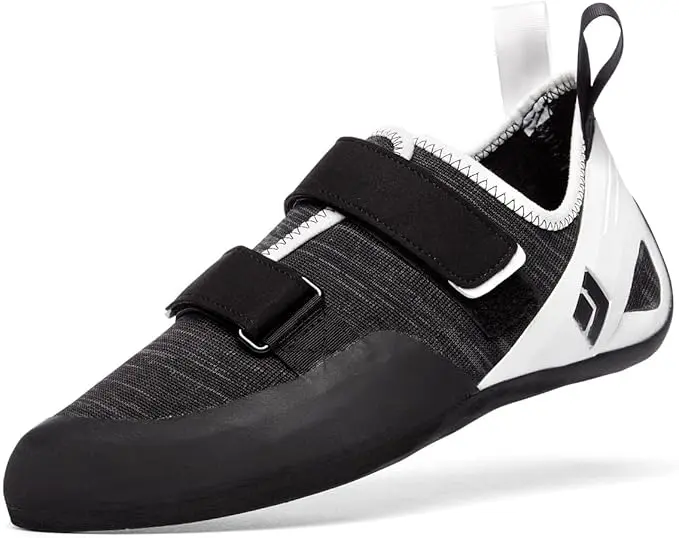
The Black Diamond Momentum climbing shoe stands out for its innovative Engineered Knit Technology upper. This material provides exceptional breathability and a sock-like comfort from the first wear, minimizing break-in time. Its flat-last, neutral profile is designed for all-day comfort, making it another excellent choice for beginners or climbers prioritizing comfort during long gym sessions or multi-pitch routes where foot fatigue can be a factor.
The shoe features Black Diamond’s durable BlackLabel-Street rubber, offering good grip, and a soft-flex midsole that enhances sensitivity for smearing on slabs. The two Velcro straps allow for quick and easy adjustments, convenient for gym climbing where shoes are often taken on and off. The microfiber liner in the forefoot helps maintain the initial fit by minimizing stretch in that critical area.
Its focus on out-of-the-box comfort and breathability makes it appealing, especially for indoor climbing. While the molded rubber might wear slightly faster indoors compared to some competitors, the overall package offers a user-friendly experience for those new to the sport or seeking maximum comfort. It’s particularly noted for accommodating wider feet well.
PROS
- Engineered Knit upper ensures breathability and comfort
- Neutral profile suits all-day wear and beginners
- BlackLabel-Street rubber grips well on moderate holds
- Two Velcro straps allow easy fit adjustments
- Lightweight (~7.4 oz/shoe) for gym and crag
- Affordable (~$90-$110) for quality
- Improves heel/toe hooks versus rentals
CONS
- Sizing runs small; 1/2 size up recommended for wide feet by some
- Sole wears quickly indoors (~6 months heavy use) according to some reports
- Heel slippage reported for some users
- Velcro may fuzz over time
- Limited precision for advanced routes
- Occasional shipping issues reported (wrong sizes, used shoes)
- Velcro version potentially less durable than lace-up version
Bouldering & Sport Climbing
Scarpa Drago | Soft, sensitive, aggressive shoe for steep terrain

The Scarpa Drago is a high-performance weapon designed specifically for the demands of modern bouldering and steep sport climbing. Its extremely soft climbing shoes construction allows climbers to feel minute details on the rock or plastic, making it excel on volumes, smears, and technical sequences. The aggressive downturn and asymmetry focus power through the big toe for maximum purchase on small, overhanging holds.
Featuring a microfiber upper that minimizes stretch, the Drago maintains its performance fit over time. Its standout feature is the extensive M50 rubber coverage on the forefoot and heel, providing unparalleled grip for complex toe and heel hooking maneuvers – essential techniques in modern climbing. The single Velcro strap combined with active rands ensures a secure, precise fit that feels almost like a slipper with added tension.
While its softness makes it less ideal for standing on tiny edges compared to stiffer shoes, its sensitivity and hooking prowess are top-tier for climbers tackling steep, powerful problems. It’s a specialized tool that shines brightest on challenging angles and requires an experienced climber to unlock its full potential. Its flexibility feels agile and precise for difficult boulder problems.
PROS
- Ultra-soft design with XS Grip2 rubber ensures top sensitivity
- M50 rubber excels for toe and heel hooking
- Aggressive downturn suits steep terrain
- Lightweight (~7.1 oz/shoe) for dynamic moves
- Durable for a soft shoe (~6-12 months moderate use)
- Comfortable for an aggressive shoe (after break-in)
- Eye-catching yellow design
CONS
- Sizing runs small; 1/2 to 2 sizes down needed
- Rubber wears fast indoors (~2-4 months)
- Weak on small edges due to softness
- Heel slippage for some users
- Premium price (~$190-$220)
- Break-in needed (~1-2 sessions)
- Occasional shipping issues reported (wrong sizes, used shoes)
La Sportiva Solution | Powerful, downturned classic for hard climbing
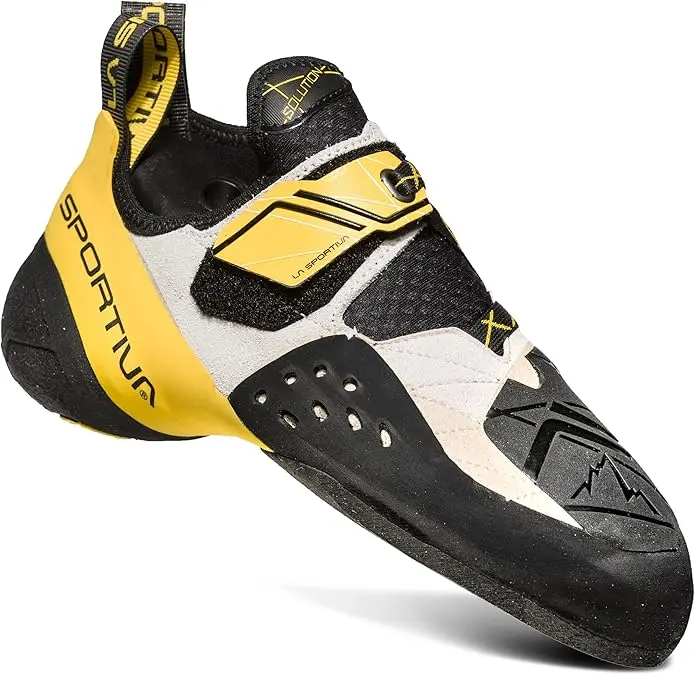
A long-standing benchmark in high-performance climbing, the La Sportiva Solution is renowned for its power and precision on difficult routes and boulder problems. Its aggressive downturn, maintained by the P3® Permanent Power Platform, channels force effectively to the toes for edging and pulling on steep terrain. The Lock Harness System® ensures a secure, glove-like fit, preventing foot slippage during demanding moves.
The combination of a supportive midsole and sticky Vibram XS Grip2 rubber makes the Solution adept at both edging on small features and executing powerful heel hooks, thanks to its 3D molded heel cup. The Fast Lacing System®, using a single Velcro strap, allows for quick and precise fit adjustments. It’s a versatile powerhouse favored by many climbers pushing their limits on technical rock.
While known for requiring a significant downsize and having laces that can wear out (often replaced with paracord), its performance capabilities keep it a top contender. It offers a stiffer feel compared to the Drago, providing more support on smaller edges, making it a classic choice for climbers seeking aggressive performance with a bit more structure. A true ultra-performance climbing shoe.
PROS
- Vibram XS Grip2 rubber excels for smearing and hooking
- P3 system and downturned last drive toe power
- Lock Harness ensures secure fit
- Durable for aggressive use (~6-12 months)
- Precise on small holds and overhangs
- Stylish White/Yellow design
- Used by pros for hard climbing
CONS
- Sizing runs small; 1-3 sizes down needed
- Laces tear quickly (~5-10 sessions) according to many reports
- Heel fit issues for some users
- Rubber wears fast indoors (~3-6 months)
- Uncomfortable for long sessions
- Premium price (~$180-$200)
- Occasional shipping issues reported (wrong sizes, used shoes)
Trad & Multi-pitch Climbing
La Sportiva TC Pro | Iconic high-top designed for all-day trad comfort

Designed in collaboration with legendary climber Tommy Caldwell, the La Sportiva TC Pro is an icon in the world of traditional and crack climbing. Its high-top design provides crucial ankle protection and support, especially valuable when jamming feet into cracks. The relatively flat, low-asymmetry profile prioritizes comfort for long days on multi-pitch routes, allowing the foot to remain in a more natural position.
Constructed with a durable leather upper and featuring Vibram XS Edge rubber, the TC Pro excels at edging on small features while offering enough stiffness (thanks to the P3® platform and stiff sole) to support the foot during sustained crack climbing. The lace-to-toe design allows for a highly adjustable fit and adds protection over the foot during jamming. Padding around the ankle and tongue further enhances comfort for alpine conditions.
While heavier and less sensitive than sport-climbing specific shoes, its blend of all-day comfort, protection, and performance on vertical to slightly overhanging terrain makes it a benchmark for trad climbers. It’s built to withstand the rigors of long routes and varied rock types, offering confidence and support high off the ground. A top choice among italian climbing shoes.
PROS
- High-top design protects ankles in cracks
- Vibram XS Edge rubber excels for edging
- P3 platform supports crack jamming
- Unlined leather ensures all-day comfort (after break-in)
- Durable for trad climbing (~12-18 months)
- Suits wide feet with stretch
- Lace-up closure offers precise fit
CONS
- Sizing runs small; size up 1/2 from street for comfort often recommended
- Toe box tight for some users
- Rubber wears on abrasive rock (~6-12 months heavy use)
- Laces may fray after ~1 year
- Dye may stain feet initially (olive color)
- Heavy (~10.8 oz/shoe) for bouldering/sport
- Occasional shipping issues reported (wrong sizes, used shoes)
Black Diamond Aspect | Durable, flat profile good for cracks and edging

The Black Diamond Aspect is engineered for the specific demands of trad climbing, focusing on durability, edging performance, and comfort for crack climbing. It features a high-grade European leather upper lined with hemp for comfort and moderate stretch, built on a neutral, flat last suitable for all-day wear. Its medium-flex midsole provides a balance of support for edging and sensitivity for smearing.
A key feature is the sticky NeoFriction Force rubber, molded for consistency and durability, offering reliable grip on various rock types, particularly granite. The lace-up closure includes an Internal Lace Protection System, shielding the laces from abrasion during crack climbing – a thoughtful detail for trad climbers. The Engineered Knit Technology tongue adds breathability and padding, enhancing comfort during long climbs or jamming.
Offering a slightly lower profile than the TC Pro but still providing excellent edging and crack performance, the Aspect is a strong contender for technical face climbing and multi-pitch routes. Its focus on durability and specific trad features, combined with a more accessible price point than some competitors, makes it a compelling option for the outdoor environment.
PROS
- Leather upper molds for comfort
- NeoFriction Force rubber excels for edging
- Flat last suits all-day trad
- Knit tongue adds breathability
- Lace protection minimizes crack pain
- Affordable for premium trad (~$130-$150)
- Good for granite and cracks
CONS
- Sizing runs small; 1/2 size up recommended by some
- Toe durability issues reported by some (~2-3 months)
- Limited sensitivity for steep terrain
- Laces may fray after ~1 year
- May feel stiff initially
- Occasional shipping issues reported (wrong sizes, used shoes)
- Broad toe box less effective in narrow pockets
Comfort-Focused Options
La Sportiva Mythos | Extremely comfortable, moldable unlined leather slipper/lace-up
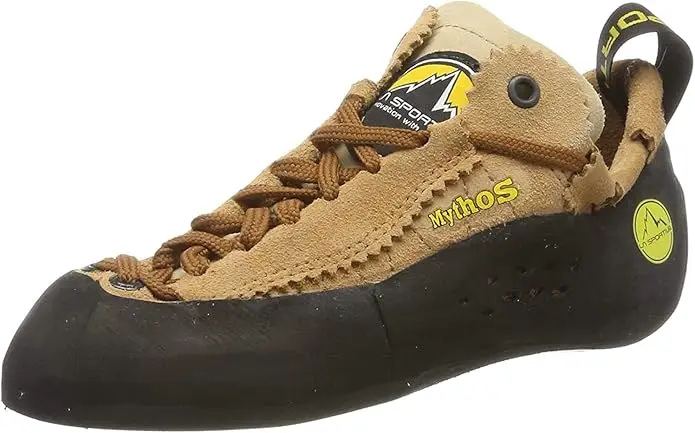
A true classic known for unparalleled comfort, the La Sportiva Mythos (especially the Eco version reviewed) is designed for climbers who prioritize all-day wearability. Its unlined leather upper is incredibly soft and molds exceptionally well to the foot over time, offering a near-custom fit. The flat, low-asymmetry last accommodates a wide variety of foot shapes comfortably.
The patented Mythos lacing system is unique, wrapping around the heel to provide a surprisingly precise and adjustable fit despite the shoe‘s soft nature. This allows climbers to dial in support where needed. While not built for high-end edging or steep overhangs, its comfort makes it a favorite for moderate multi-pitch routes, guiding, long gym sessions, and particularly crack climbing where its flexibility shines.
The Eco version utilizes recycled rubber and eco-friendly tanning processes, adding an environmental appeal. Its reputation for comfort is legendary, making it a go-to choice for those seeking a shoe they can wear for hours without pain, even if it means sacrificing some performance on harder climbs. It truly excels in long-duration scenarios, a comfortable shoe indeed.
PROS
- Unlined leather molds for exceptional comfort
- Mythos lacing system ensures precise fit
- ECO rubber grips well for moderate routes
- Durable for long routes (~12-18 months)
- Eco-friendly materials appeal to conscious climbers
- Suits wide and narrow feet
- Breathable for hot conditions
CONS
- Sizing complex; stretches ~1/4-1/2 size
- Rubber feels slick initially according to some reports
- Weak edging on small holds
- Laces complex to replace if broken
- Sole wears faster indoors (~6-9 months)
- Premium price (~$150-$170)
- Occasional shipping issues reported (wrong sizes, used shoes)
Butora Endeavor | Often cited for comfort, available in wide fit
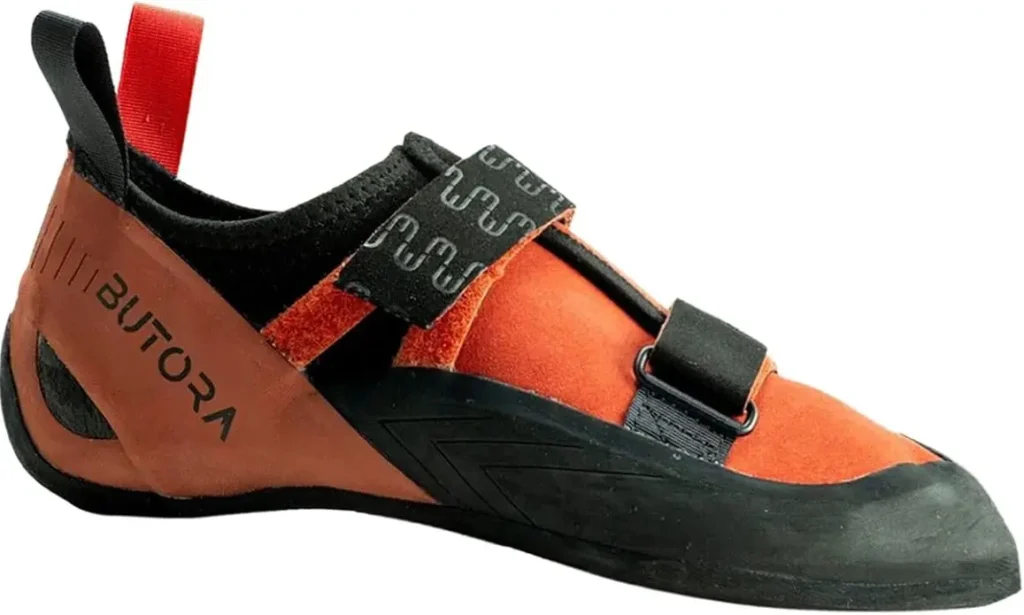
The Butora Endeavor targets the entry-level to intermediate climber seeking a comfortable, versatile shoe. Its hybrid upper combines synthetic microfiber in the front (for minimal stretch) with natural leather in the rear (for breathability), lined with odor-resistant hemp. A key selling point is its availability in both narrow and wide fits, catering specifically to climbers who struggle with standard sizing.
The slightly asymmetrical shape offers a good balance between comfort and performance for moderate climbing. It features Butora’s sticky F5 rubber and a supportive midsole for decent edging capabilities. The dual Velcro closure system, combined with a unique webbing system and padded tongue, provides a secure and customizable fit across different foot volumes.
Praised for its comfort, fit options, and odor resistance, the Endeavor is a solid all-around choice for gym climbing, sport climbing routes, and moderate outdoor adventures. Its focus on accommodating different foot widths directly addresses a common frustration for many climbers, making it a noteworthy option for those needing more room or a snugger fit than average.
PROS
- Hemp lining minimizes odor and stretch
- Triple fork webbing ensures custom fit
- F5 rubber grips well on slabs and vertical routes
- Wide/narrow fit options suit diverse feet
- Durable for moderate use (~6-12 months)
- Affordable (~$90-$110) for quality
- Comfortable for long sessions
CONS
- Sizing runs small; 1/2-2 sizes up needed according to reports
- Toe box cramped for some users
- Rubber wears fast indoors (~6 months heavy use)
- Limited toe-hooking ability (no dedicated toe rubber)
- Wide fit not wide enough for very wide (e.g., 4E) feet
- Heel slightly loose for some users
- Occasional shipping issues reported (wrong sizes, used shoes)
Final Fit Recommendations
Embarking on the quest for the perfect climbing shoe fit is a personal expedition, unique to every climber. The guiding principle remains constant: strive for a snug fit that eliminates dead space, thereby enhancing performance, yet rigorously avoid the kind of debilitating pain that risks injury and diminishes the sheer joy of climbing. It’s vital to internalize that “snug” manifests differently across shoe types; aggressive models inherently demand a tighter embrace to fulfill their design intent compared to neutral shoes crafted primarily for comfort.
Always weigh your experience level—beginners should unequivocally prioritize comfort to foster technique development. Consider your primary climbing discipline; the demands of all-day trad climbing are vastly different from short, intense boulder problems. And never underestimate the significance of your unique foot shape in determining compatibility with specific shoe lasts. Pay close attention to materials, anticipating the stretch in unlined leather while expecting synthetics to maintain their initial form steadfastly.
Given the notorious inconsistencies in brand sizing, trying shoes on in person is almost always indispensable. Test potential choices thoroughly, meticulously checking the toe box, heel security, and overall pressure distribution. Exercise patience during the break-in period, particularly with leather shoes, but learn to distinguish initial tightness from fundamental fit issues causing sharp or persistent pain points. Reject the pervasive myth that extreme pain equates to high performance. Above all, listen to your body’s signals; significant pain usually means it’s the wrong size or, more frequently, simply the wrong shape for your foot. Investing time and effort in finding the right fit is a direct investment in your climbing progression, your safety, and your long-term foot health, ultimately rewarding you with greater confidence, enhanced performance, and deeper enjoyment on the rock.
Action Items:
- Visit a climbing shoes shop with knowledgeable staff.
- Try on multiple brands, models, and sizes late in the day.
- Prioritize fit based on your primary climbing style and experience.
- Understand shoe material stretch implications.
- Walk away from shoes that cause sharp, localized pain.
Frequently Asked Questions
How tight should my first pair of climbing shoes be? >
Do climbing shoes stretch? >
Is it normal for climbing shoes to hurt? >
How often should I replace my climbing shoes? >
We are a participant in the Amazon Services LLC Associates Program, an affiliate advertising program designed to provide a means for sites to earn advertising fees by advertising and linking to Amazon.com. As an Amazon Associate I earn from qualifying purchases. We also participate in other affiliate programs. The information provided on this website is provided for entertainment purposes only. We make no representations or warranties of any kind, expressed or implied, about the completeness, accuracy, adequacy, legality, usefulness, reliability, suitability, or availability of the information, or about anything else. Any reliance you place on the information is therefore strictly at your own risk. Additional terms are found in the terms of service.











